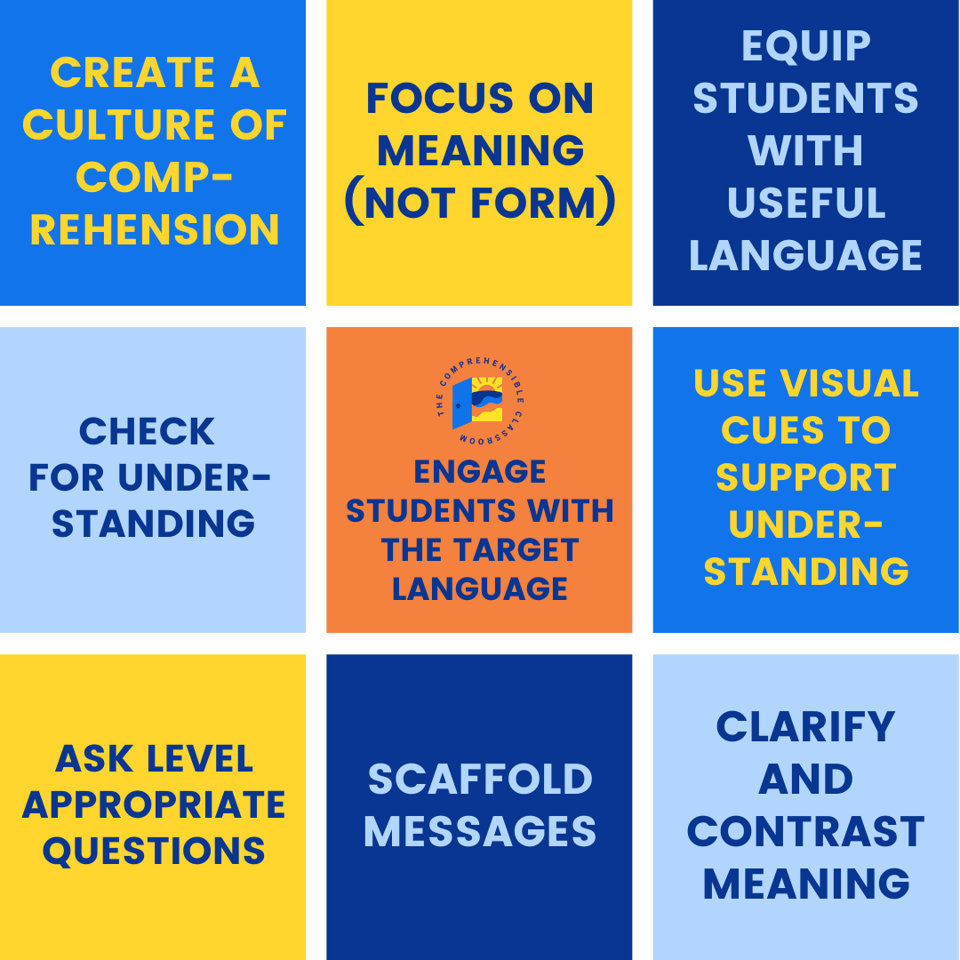Language learners develop proficiency as they spend time in environments in which the target language is used extensively and in such a way that the learners are able to process the language they are hearing or reading. In other words, "We acquire language when we understand messages: when we understand what people tell us and when we understand what we read" (S. Krashen).
Exposing our students to vast amounts of input is important, and it is also important that we ensure that they understand (are able to process) that input. If you speak Spanish, you may find it easy to provide your students with input: just talk to them in Spanish for 45 minutes and, voilà ! You've done Part 1, which is providing them with vast amounts of input. But what about Part 2? What about that processing piece?
Teaching comprehensibly means teaching to the learners in the room.

Sometimes, teachers get the impression that Comprehensible Input is just something for Novice learners. Based on this wrong assumption, they think that teaching comprehensibly means speaking with very simple sentences and using very simple vocabulary words. However, what it looks like to teach comprehensibly is context-dependent.
EVERY human acquires language as they are exposed to comprehensible input, at every stage of their language acquisition. You continue to acquire your first language even now as you are exposed to comprehensible input, and everyone from Novice learners to Superior-range language speakers acquire their additional languages through exposure to comprehensible input.
What is comprehensible to a new language learner is very different than what is comprehensible to a student that has been studying a language for 3 or 4 years. So, the first step in teaching comprehensibly is getting to know the learners in the room.
Teaching comprehensibly means finding out what is in students' heads.
In order to know what language your learners will be able to understand, you need to get a picture of what the language in their heads looks like. Think about the term "acquire language". Acquiring means getting something from somewhere else. Language acquisition is getting the language "out there" in the world and bringing it "in here" into our heads. The first thing that language teachers need to do at the start of a new school year is to get a clear view of their students' brains. What language have they acquired? What is in their heads?
Since linguistic systems are invisible, we need students to do something in order for us to see what's in their heads. When students write or speak in the target language, we get a window into that linguistic system that they have been building in their heads as they acquire language. We can see which words they've acquired, and we can see what connections have been formed between words, telling them what ways they are able to combine words together to form utterances, such as sentences.
Here are some quick ways that you can evaluate what language your students have acquired:
1) Assign a fluency write

A fluency write; also known as a quick write, a timed write, or a free write; is a fast way for you to see what students can do with the language. Click here to learn more about timed writes. Essentially, you give students a time limit (5, 7, or 10 minutes) and tell them to write as much as they can about whatever they want in that time period.
If your students are overwhelmed by all of that freedom, consider providing a few prompts for them to choose from. Show them a picture that they can describe, or suggest that they write about what they did last summer.
When you collect the timed writes, you will see which words are part of your students' vocabularies as well as the patterns that they have begun to acquire.
2) Evaluate their comprehension
Share with students a text that you think they would be able to understand. You might base your assumption on how many years of language class they have completed, or perhaps you have a better idea because you know what curriculum has been covered in previous classes. Regardless, it is not reasonable to expect that because something has been taught, students have retained it.
Choose a passage that you think students will understand, and then give them a task that will allow you to evaluate to what extent they do understand it.
Garbanzo lessons are designed for comprehension
Garbanzo is an excellent tool for evaluating students' interpretive ability– but not in the way you might think! While every Garbanzo lesson features comprehension questions that are embedded within the text itself, students' responses to those comprehension questions are not a good measure of their interpretive ability. Here's why: Garbanzo questions are processing questions. They are questions that are designed to support students in understanding what they are reading through repetition and clarification. Many of the questions are written such that students don't have to understand the text in order to respond correctly to the question. For example, the lesson text might say: "Este animal es un elefante" (This animal is an elephant), and the follow-up processing question is, "¿Es este animal un elefante o un hipopótamo?". Either/or questions in the target language do NOT make good comprehension questions... but they make GREAT processing questions.
3) Use Garbanzo lesson previews as a listening activity

To use Garbanzo to evaluate students' interpretive ability, try this trick: with your Premium Subscription, pull up the preview for a lesson that you think your students will be able to understand. You can access lesson previews from your teacher dashboard, in the lesson library. Pull up the preview on a computer with a sound system that all of your students will be able to hear; for example, from your front smart board!
Once you've pulled up the preview for the Garbanzo lesson that you want your students to try out, scroll to the very last slide of the lesson. Students are not able to skip forward in lessons without answering the embedded questions, but teachers can in preview mode. The last slide of every lesson in Garbanzo provides the full text of the lesson in a single slide.
Now, quick! Mute your screen so that students can't see the text. With your sound system turned on, push "play" on the audio bar at the top of your screen. Have your students listen to the full audio for the lesson, which was recorded by one of our amazing Voice Artists, several times. Then, tell them to write you a quick summary of what they understood from the audio text. They should write the summary in your primary shared language so that you can truly evaluate what they understood.
Repeat this process several times with several different texts, each of which represents a different level of text complexity. Collect your students' papers and read through their summaries. Make note of what things seemed to be understood by ALL of your students, and which were the pieces of each text that seemed to be misunderstood or missed?
Listening activity for Standard subscribers
Audio is available for all lessons with Garbanzo's Premium Subscription. If you have a Standard subscription, you can still use Garbanzo to evaluate your students' interpretive ability. Follow all the steps laid out above to locate a lesson and navigate to the last slide of the lesson that contains the full text. Then, use your OWN voice to read aloud the text to your students while they listen and make note of what they understand. Easy peasy!
4) Engage in conversation

Another way to evaluate what language your students have acquired is to start talking with them. Pick a topic and have a conversation! Pay close attention to your students' understanding and especially to their breakdowns in understanding. Use strategies such as teaching to their eyes and asking comprehension questions to evaluate their understanding!
If you are not accustomed to leading a conversation with your students, a great place to start is with Card Talk or Special Person Interviews. Both of these strategies offer flexibility in what language you can use during the conversation, which makes them perfect for evaluating your students' acquired language at the start of the school year.
Now, it's time to teach comprehensibly!
Once you have a good picture of what your students can understand, it's time to move forward. Every day in class, your goal is to (1) provide students with communicatively-embedded input and (2) make sure that they understand it.
Input can look like telling your students a story, creating a character together, playing a game, or teaching them about something interesting.
As you engage with your students in communication, ensure you help them understand. If they're not understanding– you're not communicating! Some essential techniques that you can use to help students understand messages are found in this blog post.
If you're curious to learn more about teaching for acquisition–and how to teach comprehensibly from Day 1–I invite you to follow the four simple steps in this post.

Garbanzo helps you teach comprehensibly.
Whether you are new to teaching Spanish for acquisition or consider yourself a seasoned pro, Garbanzo is your language teacher best friend. Our lesson library now boasts over 1200 stories and informational texts, and they are all written strategically to support students at different levels. Search our lesson library or use our amazingly detailed Garbanzo Planning Companion to identify lessons that you think your students will understand, and then use the tools in your teacher dashboard to monitor students' progress.
With so many texts on any topic you can imagine, your students are sure to find something to read that will be interesting and understandable to them, gently pushing them forward in their Spanish language learning journey.



